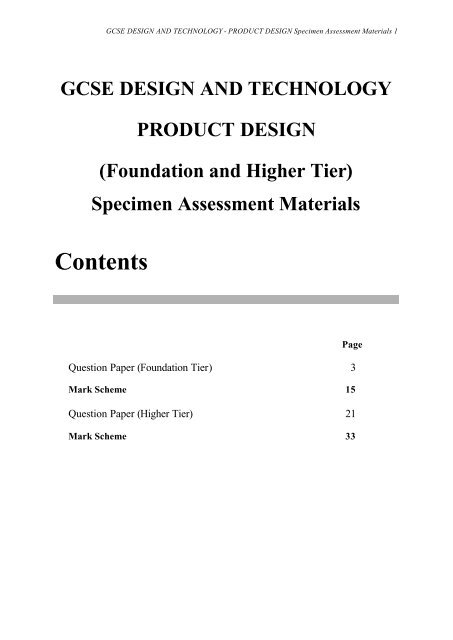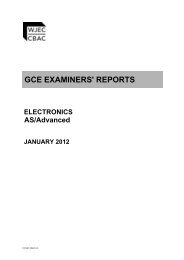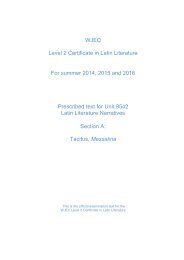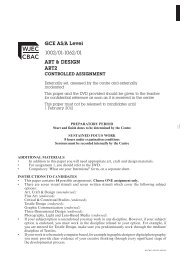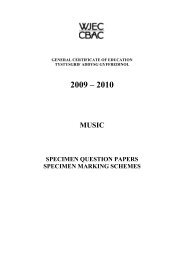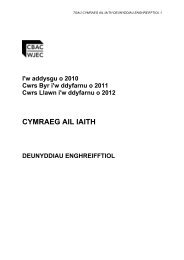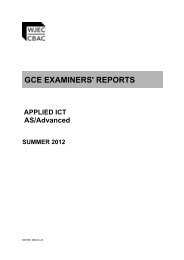GCSE Product Design Specimen Assesment Materials - WJEC
GCSE Product Design Specimen Assesment Materials - WJEC
GCSE Product Design Specimen Assesment Materials - WJEC
You also want an ePaper? Increase the reach of your titles
YUMPU automatically turns print PDFs into web optimized ePapers that Google loves.
<strong>GCSE</strong> DESIGN AND TECHNOLOGY - PRODUCT DESIGN <strong>Specimen</strong> Assessment <strong>Materials</strong> 1<strong>GCSE</strong> DESIGN AND TECHNOLOGYPRODUCT DESIGN(Foundation and Higher Tier)<strong>Specimen</strong> Assessment <strong>Materials</strong>ContentsPageQuestion Paper (Foundation Tier) 3Mark Scheme 15Question Paper (Higher Tier) 21Mark Scheme 33
<strong>GCSE</strong> DESIGN AND TECHNOLOGY - PRODUCT DESIGN <strong>Specimen</strong> Assessment <strong>Materials</strong> 3Candidate Name Centre name Candidate NumberWELSH JOINT EDUCATION COMMITTEEGeneral Certificate of Secondary EducationCYD BWYLLGOR ADDYSG CYMRUTystysgrif Gyffredinol Addysg Uwchradd144/02DESIGN AND TECHNOLOGYPAPER 2FOCUS AREA: PRODUCT AND DESIGN(Foundation Tier – Grades G to C)SPECIMEN PAPER(1 ½ hours)LeaveBlankQuestion 1Question 2Question 3Question 4Question 5TOTAL MARKINSTRUCTIONS TO CANDIDATESWrite your name, centre number and candidate number in the spaces at the top of this page.Answer all questions.Write your answers in the spaces provided in this booklet. Where the space is not sufficient for your answer,continue the answer at the back of the book, taking care to number the continuation correctly.INFORMATION FOR CANDIDATESThe number of marks is given in brackets at the end of each question or part-question.No certificate will be awarded to a candidate detected in any unfair practice during the examination
<strong>GCSE</strong> DESIGN AND TECHNOLOGY - PRODUCT DESIGN <strong>Specimen</strong> Assessment <strong>Materials</strong> 4Answer all questions in the spaces provided.1. The photograph below shows some details of a table lamp. The bridge and tube end stops are madefrom Beech wood. The lamp has a diffuser made from a plastic material.DiffuserBridgeEnd stopsThe lighting unit shown above was designed and made in school(a) (i) Beech is a hardwood used in the lamp. Name one other hardwood. [1]...................................................................................(ii) Name one softwood that could be used in the lamp. [1]...................................................................................(b) (i) Underline the most suitable plastic material that could be used to make the diffuser,from the list below. [1]Polystyrene Acrylic ABS Polypropylene(ii) Explain one advantage of using your chosen plastic for the diffuser. [2]Advantage : …………………………………………………………………………….………………………………………………………………………………………….
<strong>GCSE</strong> DESIGN AND TECHNOLOGY - PRODUCT DESIGN <strong>Specimen</strong> Assessment <strong>Materials</strong> 5(iii) State two reasons why the diffuser is necessary on the lamp. 2 × [2]Reason 1: …………………………………………………………………………….....……………………………………………………………………………………….....Reason 2: …………………………………………………………………………….....……………………………………………………………………………………….....(c) The lamp has been designed to meet BSI Standards. State the meaning of the letters BSI. [3]B……………………… S…………………… I……………………(d)The table lamp has been designed to appeal to a specific target group.(i)Identify the target group for this table lamp.The target group is ………………………………………...... [1](ii) Give two reasons why it could appeal to this target group. 2 × [2]Reason 1:…………………………………………………………………………………………………………………………………………………………………………Reason 2: ……………………………………………………………………………..…………………………………………………………………………………………17 Marks
<strong>GCSE</strong> DESIGN AND TECHNOLOGY - PRODUCT DESIGN <strong>Specimen</strong> Assessment <strong>Materials</strong> 62. The design for a desk clock is shown below. The designer has chosen to make the clock body andface from 3mm thick plastic sheet material.(a) (i) Name a suitable specific plastic material which could be used to make the clock andgive two reasons for your choice:Plastic material: ………………………………… [1]Reason: ……………………………………………………………………..................……………………………………………………………………………………. [2]Reason: ………………………………………………………………………..............…………………………………………………………………………………… [2](ii)Name a suitable adhesive for joining the plastic you have named in part (i).……………………………………… [1](b)Use notes and sketches to explain how you would form the curved body of the clock from the3mm thick plastic sheet. [5]
<strong>GCSE</strong> DESIGN AND TECHNOLOGY - PRODUCT DESIGN <strong>Specimen</strong> Assessment <strong>Materials</strong> 7(c)The diagram below shows the design of the clock face. The clock face is made using CAM.(i) Name a specific CAM machine you could use to make the markings on the clock face. [1]………………………………………………….(ii)Complete the table below to describe the main steps you would follow in using thisCAM machine to make the markings on the clock face. [5]StepDescriptionStep 1…………………………………………………………………..…………………………………………………………………..Step 2…………………………………………………………………..…………………………………………………………………..Step 3…………………………………………………………………..…………………………………………………………………..Step 4…………………………………………………………………..…………………………………………………………………..Step 5…………………………………………………………………..…………………………………………………………………..17 Marks
<strong>GCSE</strong> DESIGN AND TECHNOLOGY - PRODUCT DESIGN <strong>Specimen</strong> Assessment <strong>Materials</strong> 83. Study the photographs below. They show three "stick" type cosmetic products.A B C(a)Think about the packaging of the three products and answer the following questions.(i) Explain why product A might be more environmentally friendly than product C. [2]………………………………………………………………………………………….………………………………………………………………………………………….(ii)The packaging of product C includes a plastic liner that holds the product.State one method of making the plastic liner. [2]………………………………………………………………………………………….(iii)The card packages for products B and C have been laminated.Give one reason for this. [2]…………………………………………………………………………………………..………………………………………………………………………………………….
<strong>GCSE</strong> DESIGN AND TECHNOLOGY - PRODUCT DESIGN <strong>Specimen</strong> Assessment <strong>Materials</strong> 9(b)The designer decided to make a block model of the productshown alongside.(i)The table below lists a selection of materials that couldbe used for the block model.Complete the table by filling in the gaps. [6]Name of Material MaterialTypeSuitableAdhesiveSuitableFinishMDF PVA adhesive VarnishAcrylicNo finish neededCardboard Paper PaintExpanded PolystyreneFill and Paint(ii) State which of these materials you would use to make the model. [1]………………………………………………Explain why you have selected this material. [2]………………………………………………………………………………….............………………………………………………………………………………….............(c)Use the grid below to make sketches of each of the parts you would have to make to producethe block model. [6]21 Marks
<strong>GCSE</strong> DESIGN AND TECHNOLOGY - PRODUCT DESIGN <strong>Specimen</strong> Assessment <strong>Materials</strong> 104. Kettles are made in a range of different shapes and sizes but they all have the same function. Studythe pictures of products and their details shown below.Kettle AThe Russell Hobbs cordless electric jug kettle makes aheating noise as soon as it is switched on.It has a flat plate element.It has a neon power indicator.It has a water level window.It has an easy fill hinged lid.The body is made by Injection moulding frompolythene.It costs £18.00.Kettle BThe Alessi post modern kettle was designed by RobertGraves.It has a little bird which makes a whistling noise whenthe water reaches boiling point.Water is heated by placing the kettle on a heat source.It has a broad flat base.It has a polyamide handle and a stainless steel body andspout.Cost £75.00(a) Explain why the window shown in Kettle A could help the user to save energy. [2]…………………………………………………………………………………………….........…………………………………………………………………………………………….........(b)Kettle A has been manufactured by injection moulding. Explain why this method ofmanufacture is suitable. [2]……………………………………………………………………………………………….....………………………………………………………………………………………………....
<strong>GCSE</strong> DESIGN AND TECHNOLOGY - PRODUCT DESIGN <strong>Specimen</strong> Assessment <strong>Materials</strong> 11(c) Give three reasons why Kettle B is more expensive than Kettle A. 3 × [2]Reason 1 ………………………………………………………………………………….........…………………………………………………………………………………………….........Reason 2…………………………………………………………………………………...........…………………………………………………………………………………………….........Reason 3………………………………………………………………………………….........……………………………………………………………………………………………........(c)Evaluate one chosen kettle under the following headings:Chosen Kettle ………………..(i) Ergonomic features [3]………………………………………………………………………………………....………………………………………………………………………………………....………………………………………………………………………………………....………………………………………………………………………………………...………………………………………………………………………………………...(ii) Aesthetics (visual appearance) [3]………………………………………………………………………………………….………………………………………………………………………………………….………………………………………………………………………………………….………………………………………………………………………………………….
<strong>GCSE</strong> DESIGN AND TECHNOLOGY - PRODUCT DESIGN <strong>Specimen</strong> Assessment <strong>Materials</strong> 12(d) (i) The diagram below shows the four stages in a product lifecycle.SalesLaunch Growth Saturation DeclineTime(ii) Choose two of the stages and describe what happens to product sales. 2 × [2]Stage …………………………………………………………………………………………………………………..…………………………………………………………………………………………..Stage ………………………………………………………………………………………………………………….…………………………………………………………………………………………..20 marks
<strong>GCSE</strong> DESIGN AND TECHNOLOGY - PRODUCT DESIGN <strong>Specimen</strong> Assessment <strong>Materials</strong> 135. Salt and pepper shakers have traditionally looked like the wooden set shown below left.<strong>Product</strong> designers working for Alessi have transformed the traditional product into a fun yetfunctional form of shaker called Lilliput's fleas shown below right.Traditional Salt and Pepper mill.Alessi designed Lilliput's fleasBriefYou have been asked to re-design the lever armcorkscrew shown alongside to reflect a more updated design.SpecificationYour design must:• reflect a theme of your choice;• use a rack and pinion mechanism as astarting point;• include a suitable form for the handle;• have a suitable shape for the body andstyle of lever arms.(a)Sketch your design on the opposite page.Marks will be awarded for:(i)showing clear details of the lever arms, shape of the body and form of the handlewhich reflects an fun theme; [7](ii) showing the use of a rack and pinion mechanism; [6](iii) including details of materials and components used; [4](iv) two important dimensions of the handle [2](v) quality of communication including the use of colour. [6]
<strong>GCSE</strong> DESIGN AND TECHNOLOGY - PRODUCT DESIGN <strong>Specimen</strong> Assessment <strong>Materials</strong> 14For design sketch:
<strong>GCSE</strong> DESIGN AND TECHNOLOGY - PRODUCT DESIGN <strong>Specimen</strong> Assessment <strong>Materials</strong> 15Welsh Joint Education CommitteeGeneral Certificate of Secondary EducationCyd-Bwyllgor Addysg CymruTystysgrif Gyffredinol Addysg UwchraddDESIGN AND TECHNOLOGY144 / 02PRODUCT DESIGNSPECIMEN PAPER 2FOUNDATION TIERQ1(a) (i)Award one mark for one of the following:Elm, Oak, Ash, Mahogany, Teak, Walnut, Maple, Obeche, Jelutong.1 mark [1](ii)(b) (i)Spruce, pitch pine, parana pine, yew.Award one mark for the most suitable plastic that could be used toform the diffuser:Polypropylene.1 mark[1](ii)Award up to two marks for a detailed response which showsunderstanding and only one mark for basic response:• It can be bent into shape• It can easily be formed into unusual shapes because it is athermoplastic;• It is thin• Because it can be manufactured in various thicknesses, itcan be made to be lightweight;• It lets light through• It can be manufactured with various degrees of transparencyfrom opaque to transparent.1 mark2 marks1 mark2 marks1 mark2 marks1 x [2](iii)Award up to two marks for a detailed response which showsunderstanding and only one mark for basic response:• To protect the eyes• To offer protection from the possible glare of the light bulb;• To make it look more attractive• To improve the visual appeal of the product2 marks1 mark2 marks1 mark2 marks2 x [2]marks(c) British Standards Institute 3 marks [3](d)(i)Do not award a mark for one of the following but the example mustbe given:Target Audience - people with an interest in sailing, men or boys.1 mark[1](ii)Award one mark for one of the following:• It has innovative or unusual styling;• The design appears to be based on a sailing vessel.1 mark[2]
<strong>GCSE</strong> DESIGN AND TECHNOLOGY - PRODUCT DESIGN <strong>Specimen</strong> Assessment <strong>Materials</strong> 16Q2(a) (i)Award one mark for a specific plastic:Acrylic, Foamex, ABS, Polystyrene.1 mark[1]Award one mark for each appropriate reasons that shows anunderstanding of properties of the material:It has an attractive shiny appearance;It can be formed into a curved shape;It comes with a high quality surface finish;The edge can be cleaned up and polished.2 mark2 mark2 mark2 mark2 x [2]Award one mark for reference to:strong,tough,rigid,durable if they are appropriate for the named material.1 mark1 mark1 mark1 markDo not award 'Bendy' cheap/light/ lightweight/heavyAward one mark for an appropriate property of a material namedeven if the material is not given credit because it is not suitable formaking the clock.(ii)Award one mark for an appropriate adhesive.Tensol, Epoxy Resin, Plastic weld, liquid solvent cement, contactadhesive, Tensol superglue.Do not award any marks for glue gun.Credit Tep – ultra-violet activated glue1 mark[1](b)Award marks for any appropriate sketch / sketches with suitableannotation which clearly communicates knowledge of the process.Reward Any 3 of:Draw a diagram of the former;Drape sheet material over the former and heating material up;Clamping material in former until cool.3 marks[5]Then reward:quality of communicationNo marks for cleaning up edgesIf there is no diagram, award a maximum of 4 marks2 marks(c) (i)(ii)Award one mark for one of the following:Do not give credit for trade names :Boxford, Denford, Roland or'lathe'Award one mark for each appropriate stage for one of the folmethods:Using vinyl – CAMM1/StikaComplete drawing on 2D <strong>Design</strong> / Corel Draw and ensure theoutline – no fillLoad vinyl into machine / Select plotTake out vinyl and/or remove waste materialApply backing tape and lift off designApply carefully to clock face and rub down1 mark [1]5 × [1] [5]
<strong>GCSE</strong> DESIGN AND TECHNOLOGY - PRODUCT DESIGN <strong>Specimen</strong> Assessment <strong>Materials</strong> 17Using CAMM2 or equivalent millerComplete drawing on 2D <strong>Design</strong>/Corel Draw and ensure the outlineSet engraving depth, line colour and depth per pass.Use tape to stick plastic onto bedSet machine parameters/z axisClose cover and run machine/remove when finished andremove wasteUsing Laser CutterLoad up Corel/2D design softwareSet speed and powerCut material to sizePosition material on bed of machineRun machine5 × [1] [5]5 × [1] [5]Q3(a) (i)Award up to two marks for a detailed response which showsunderstanding of why product A is environmentally sound and onlyone mark for basic response based on:<strong>Product</strong> A uses less materials and has only the essential parts;<strong>Product</strong> A requires less energy in manufacture because thereare fewer pieces to make;The product takes up less space in transportation thereforemore can be carried in one journey thus saving fuel costs andresources.2 marks2 marks2 marks[2]Less materials.1 mark(ii)Vacuum forming2 marks[2](iii)Award up to two marks for a detailed response which showsunderstanding of why lamination is used on packaging and only onemark for basic response based on:The packaging material is made stronger;The packaging material has a harder wearing surface;A package can be made to look expensive;To make it look glossy.2 marks2 marks2 mark1 mark[2](b) • Wood, man made board• Plastic / thermoplastic / Tensol Cement• Pritt, hot melt glue, double sided tape, PVA• Plastic / Foamed plastic / PVA, double sided tape1 mark1+1 mark1 mark1+1 mark[6](ii)Award one mark for the name of a material chosen to make themodel.Award up to two marks for a detailed response which showsunderstanding of why the material is suitable for a package basedon:Ease of cutting, ease of shaping, joining, finishing 2 marks [2](c)Award one mark for:Parts drawn are the lipstick;Parts drawn would fit together;Drawings show details of the model;Quality of drawings.2 mark1 mark1 mark2 mark[6]
<strong>GCSE</strong> DESIGN AND TECHNOLOGY - PRODUCT DESIGN <strong>Specimen</strong> Assessment <strong>Materials</strong> 18Q4 (a) Award up to two marks for a detailed response which showsunderstanding of why the kettle could be energy efficient.The window on Kettle A could have a measurement scale marked inunits representing a cup or mug indicating exactly how much wateris needed for making a drink for a specific number of people. Byonly boiling the amount needed, no excess water is boiled andtherefore some energy is saved. It is guesswork with the other twokettles which could be wasting energy.2 marks [2](b)Award up to two marks for a detailed response which showsunderstanding of why injection moulding is suitable or one mark foreach of two relevant statements.It can be used to produce complex 3-dimensional shapes;Metal inserts can be included;High volume is achieved with consistent quality;Moulds are expensive to produce and thus, large numbers must bemade to ensure maximum return for the company;Initial set up costs are high and large numbers must be made toensure maximum return for the company.1 mark1 mark1 mark2 marks2 marks[2](c)Award up to two marks for a detailed response which shows threeappropriate reasons why kettle B is more expensive that kettle A.• Kettle B is made from stainless steel which is moreexpensive than polythene;• Kettle B has a novelty feature of a 'singing bird' which actsto warn the user that the kettle is boiling;• The kettle has a designer label/ name which nearly alwaysattracts a higher price.2 marks2 marks2 marks3 x [2](d) (i)Candidates must identify the specific kettle to be evaluated.Comments must be specific to the kettle identified – not general.Responses could be based on the following:Ergonomics• How it is able to let the user know that the water is boiling;• How quickly it is likely to boil water;• How much effort is needed to lift and fill/pour water;• How much grip there is on the handle to hold the kettle.1 mark1 mark1 mark1 +1 mark[3](ii)Styling• How effective is the shape or form;• How does the shape of form affect the way the kettle ismade:• How appropriate are the specific styling features onindividual kettles;• What is the relationship between the cost and styling details.• The use of materials which affect colour and texture.1 mark1 mark1 mark1 mark1 mark[4]
<strong>GCSE</strong> DESIGN AND TECHNOLOGY - PRODUCT DESIGN <strong>Specimen</strong> Assessment <strong>Materials</strong> 19(e) (i)Award up to two marks for stating what happens to the product ateach of two four stagesLaunch: sales of a product are slow because promotion strategiesare just introducing the product to the target group;2 marks2 ×[2]The product is made available for sale.1 markGrowth – sales increase because the product is becomingfashionable and more people are buying it;More people are buying it.2 marks1 markSaturation – Sales of the product level off. Most of the target grouphave bought it;Most people have bought it.2 marks1 markDecline – Very few people now want to buy the product as it is nolonger popular or the fashion is over;The product is going out of fashion.2 marks1 markQ5 (a) (i) Award marks for:Showing clear labelled sketches of your design for the corkscrewlever arms, body shape, form of handle and innovation.Limited response;Feasible solution – some detail of components used;Detailed solution that offers a feasible solution with clear referenceto lever arms, body shape, form of handle and general theme.Limited response – suggesting use of rack and pinion system;Feasible solution – some detail of rack and pinion system;Detailed solution that offers a feasible solution with goodunderstanding of the rack and pinion system.2-3 marks4-5 marks6-7 marks1-2 marks3-4 marks6-7 marks[7][6]Names of four suitable materials/components used. 4 × 1 marks [4]Award one mark for each appropriate dimension.Two important dimensions. 2 × 1 marks [2]Quality of Communication and use of colourWeakSatisfactoryGoodExcellent1-2 marks3-4 marks5 marks6 marks[6]Total Marks for Paper [100]
<strong>GCSE</strong> DESIGN AND TECHNOLOGY - PRODUCT DESIGN <strong>Specimen</strong> Assessment <strong>Materials</strong> 21Candidate Name Centre name Candidate NumberWELSH JOINT EDUCATION COMMITTEEGeneral Certificate of Se condary EducationCYD BWYLLGOR ADDYSG CYMRUTystysgrif Gyffredinol Addysg Uwchradd144/04DESIGN AND TECHNOLOGYPAPER 2FOCUS AREA: PRODUCT AND DESIGN(Higher Tier – Grades D to A*)SPECIMEN PAPER(1 ½ hours)LeaveBlankQuestion 1Question 2Question 3Question 4Question 5TOTAL MARKINSTRUCTIONS TO CANDIDATESWrite your name, centre number and candidate number in the spaces at the top of this page.Answer all questions.Write your answers in the spaces provided in this booklet. Where the space is not sufficient for your answer,continue the answer at the back of the book, taking care to number the continuation correctly.INFORMATION FOR CANDIDATESThe number of marks is given in brackets at the end of each question or part-question.No certificate will be awarded to a candidate detected in any unfair practice during the examination.
<strong>GCSE</strong> DESIGN AND TECHNOLOGY - PRODUCT DESIGN <strong>Specimen</strong> Assessment <strong>Materials</strong> 22Answer all questions in the spaces provided.1. The photograph below shows some details of a table lamp. The bridge and tube end stops are madefrom Beech wood. The lamp has a diffuser made from a plastic material.DiffuserBridgeEnd stops(a) Name one other hardwood that could be used in place of beech. [1].....................................................................................(b) (i) Name one suitable specific plastic material that could be used to make the diffuser. [2].........................................................................(ii)Give two advantages of using your chosen plastic over laminated wood for thediffuser. 2 × [2]Advantage 1:…………………………………………………………………………...………………………………………………………………………………………....Advantage 2: ……………………………………………………………………….....………………………………………………………………………………………....(iii) Explain why the diffuser is necessary on the lamp. [2]………………………………………………………………………………………....………………………………………………………………………………………....………………………………………………………………………………………....
<strong>GCSE</strong> DESIGN AND TECHNOLOGY - PRODUCT DESIGN <strong>Specimen</strong> Assessment <strong>Materials</strong> 23(d) Describe one important safety test that should be carried out before the lamp is used. [2]………………………………………………………………………………………………....………………………………………………………………………………………………....………………………………………………………………………………………………....(e)The design for this table lamp will only appeal to a limited target audience.(i) Explain the term target audience. [1]…………………………………………………………………………………............…………………………………………………………………………………............(ii)Identify the target audience for this table lamp and give two reasons why it willappeal to them. [2]Target Audience …………………………………………………………………........Reason 1:…………………………………………………………………………................................................................................................................................................Reason 2: …………………………………………………………………..................……………………………………………………………………………....................14 Marks
<strong>GCSE</strong> DESIGN AND TECHNOLOGY - PRODUCT DESIGN <strong>Specimen</strong> Assessment <strong>Materials</strong> 242. The design for a desk clock is shown below. The designer has chosen to make the clock body andface from 3mm thick plastic sheet material.(a) (i) Name a suitable specific plastic material which could be used to make the clock andgive two reasons for your choice:Plastic material: ………………………………… [1]Reason: ……………………………………………………………………………..…………………………………………………………………………………… [1]Reason: ……………………………………………………………………………..………………………………………………………………………………….... [1](ii)Name a suitable adhesive for joining the plastic you have named in part (i).……………………………………… [1](b)Use notes and sketches to explain how you would form the curved body of the clock from the3mm thick plastic sheet. [5]
<strong>GCSE</strong> DESIGN AND TECHNOLOGY - PRODUCT DESIGN <strong>Specimen</strong> Assessment <strong>Materials</strong> 25(c)The diagram below shows the design of the clock face. The clock face is made using CAM.(i)Name a specific CAM machine you could use to make the markings on the clock face.[1]………………………………………………….(ii)Explain in detail how you would use this CAM machine to make the markings on theclock face. [4]……………………………………………………………………………………………………………………………………………………………………………....……………………………………………………………………………………....……………………………………………………………………………………....……………………………………………………………………………………....(iii) List two advantages to the manufacturer of using CAM in volume production. [2]Advantage 1: ……………………………………………………………………….……………………………………………………………………………………....Advantage 2: ……………………………………………………………………....……………………………………………………………………………………....16 Marks
<strong>GCSE</strong> DESIGN AND TECHNOLOGY - PRODUCT DESIGN <strong>Specimen</strong> Assessment <strong>Materials</strong> 263. Study the photographs below. They show three "stick" type cosmetic products.A B C(a)Think about the packaging of the three products and answer the following questions.(i) Explain why product A might be more environmentally friendly than product C. [2]……………………………………………………………………………………………………………………………………………………………………………………(ii)The packaging of product C includes a plastic liner that holds the product.State one method of making the plastic liner. [2]…………………………………………………………………………………………(iii)The card packages for products B and C have been laminated.Give one reason for this. [2]………………………………………………………………………………………….………………………………………………………………………………………….(b)Apart from holding and protecting the product, explain why the designer has included aplastic liner in package C. [2]…………………………………………………………………………………………............……………………………………………………………………………………….................
<strong>GCSE</strong> DESIGN AND TECHNOLOGY - PRODUCT DESIGN <strong>Specimen</strong> Assessment <strong>Materials</strong> 27(c)The designer decided to make a block model of the productshown alongside.(i)The table below lists a selection of materials that couldbe used for the block model.Complete the table by filling in the gaps. [6]Name of Material MaterialTypeSuitableAdhesiveSuitableFinishMDF PVA adhesive VarnishAcrylicNo finish neededCardboard Paper PaintExpanded PolystyreneFill and Paint(ii)State which of these materials you would use to make the model.………………………………………………Explain why you have selected this material. [2]………………………………………………………………………………….............………………………………………………………………………………….............(d)Use the grid below to make sketches of each of the parts you would have to make to producethe block model. [4]20 Marks
<strong>GCSE</strong> DESIGN AND TECHNOLOGY - PRODUCT DESIGN <strong>Specimen</strong> Assessment <strong>Materials</strong> 284. Kettles are made in a range of different shapes and sizes but they all have the same function. Studythe pictures of products and their details shown below.Kettle AThe Russell Hobbs cordless electric jug kettle makes aheating noise as soon as it is switched on.It has a flat plate element.It has a neon power indicator.It has a water level window.It has an easy fill hinged lid.The body is made by Injection moulding frompolythene.It costs £18.00.Kettle BThe Alessi post modern kettle was designed by RobertGraves.It has a little bird which makes a whistling noise whenthe water reaches boiling point.Water is heated by placing the kettle on a heat source.It has a broad flat base.It has a polyamide handle and a stainless steel body andspout.Cost £75.00Kettle CThe Russell Hobbs traditional style electric kettle.It has a conventional heating element.It has a simple bi-metallic switch.It has a broad flat base.It has an Urea formaldyhyde handle and a stainlesssteel body and spout.Cost £28.00(a)Explain how the window shown in Kettle A could help to make it potentially more energyefficient than the other two kettles. [2]……………………………………………………………………………………………….....……………………………………………………………………………………………….....
<strong>GCSE</strong> DESIGN AND TECHNOLOGY - PRODUCT DESIGN <strong>Specimen</strong> Assessment <strong>Materials</strong> 29(b)Kettle A has been manufactured by injection moulding. Explain why this method ofmanufacture is only suitable for large scale production. [2]…………………………………………………………………………………………….........……………………………………………………………………………………………........(c)Evaluate one chosen kettle under the following headings:Chosen Kettle ………………..(i) Functional and ergonomic considerations [4]……………………………………………………………………………………….....……………………………………………………………………………………….....………………………………………………………………………………………....………………………………………………………………………………………....………………………………………………………………………………………....………………………………………………………………………………………....(ii) Styling. [4]………………………………………………………………………………………...………………………………………………………………………………………...………………………………………………………………………………………...………………………………………………………………………………………...………………………………………………………………………………………...………………………………………………………………………………………...(iii) <strong>Materials</strong> [4]………………………………………………………………………………………………………………………………………………………………………………………………………………………………………………………………………………………………………………………………………………………………………………………………………………………………………………………………........
<strong>GCSE</strong> DESIGN AND TECHNOLOGY - PRODUCT DESIGN <strong>Specimen</strong> Assessment <strong>Materials</strong> 30(d) (i) Complete the diagram below to show the four stages in a product lifecycle. [4]SalesTime(ii)Using your diagram, explain where the manufacturer should consider introducing anew version of a new product. [2]……………………………………………………………………………………………………………………………………………………………………………………(iii) Outline three implications for the manufacturer in re-designing the new product. [3]................................................................................................................................................................................................................................................................................................................................................................................................................................................................................................................................................................25 Marks
<strong>GCSE</strong> DESIGN AND TECHNOLOGY - PRODUCT DESIGN <strong>Specimen</strong> Assessment <strong>Materials</strong> 315. Salt and pepper shakers have traditionally looked like the wooden set shown below left.<strong>Product</strong> designers working for Alessi have transformed the traditional product into a fun yetfunctional form of shaker called Lilliput's fleas shown below right.Traditional Salt and Pepper mill.Alessi designed Lilliput's fleasBriefYou have been asked to re-design the lever armcorkscrew shown alongside to reflect a more updated design.SpecificationYour design must:• reflect a theme of your choice;• use a rack and pinion mechanism as astarting point;• include a suitable form for the handle;• have a suitable shape for the body andstyle of lever arms.(a)Sketch your design on the opposite page.Marks will be awarded for:(i)showing clear details of the lever arms, shape of the body and form of the handlewhich reflects an innovative theme; [6](ii) showing the use of a rack and pinion mechanism; [5](iii) including details of materials and components used; [4](iv) two important dimensions of the handle [2](v) quality of communication including the use of colour. [5](b) Select one material used in the design and explain why it is a good choice. [3]………………………………………………………………………………………………....………………………………………………………………………………………………....………………………………………………………………………………………………....………………………………………………………………………………………………....
<strong>GCSE</strong> DESIGN AND TECHNOLOGY - PRODUCT DESIGN <strong>Specimen</strong> Assessment <strong>Materials</strong> 32For design sketch:
<strong>GCSE</strong> DESIGN AND TECHNOLOGY - PRODUCT DESIGN <strong>Specimen</strong> Assessment <strong>Materials</strong> 33Welsh Joint Education CommitteeGeneral Certificate of Secondary EducationCyd-Bwyllgor Addysg CymruTystysgrif Gyffredinol Addysg UwchraddDESIGN AND TECHNOLOGY144/04PRODUCT DESIGNSPECIMEN PAPER 2HIGHER TIERQ1 (a) Award one mark for one of the following:Elm, Oak, Ash, Mahogany, Teak, Walnut, Maple, Obeche, Jelutong,1 mark [1](b) (i)Award one mark for a suitable plastic that could be used to form thediffuser:Polypropylene, Polycarbonate.2 mark[2](ii)Award up to two marks for a detailed response which showsunderstanding and only one mark for basic response:• It can be bent into shape;• It can easily be formed into unusual shapes because it is athermoplastic;• It is thin;• Because it can be manufactured in various thicknesses, itcan be made to be lightweight;• It lets light through;• It can be manufactured with various degrees of transparencyfrom opaque to transparent.1 mark2 marks1 mark2 marks1 mark2 marks2 x [2](c)Award up to two marks for a detailed response which showsunderstanding and only one mark for basic response:• To protect the eyes;• To offer protection from the possible glare of the light bulb;• To make it look more attractive;• To improve the visual appeal of the product.1 mark2 marks1 mark2 marks[2](d)Award up to two marks for a detailed response which showsunderstanding and only one mark for basic response.• It must be PAT tested;• It must be PAT tested to guarantee electrical safety for theuser when it is used under normal circumstances.1 marks2 marks[2](e) (i)Target Audience – a group of people who share common features,for example the same age, gender, likes or interests.1 mark[1](ii)Do not award a mark for one of the following but the example mustbe given:Target Audience - people with an interest in sailing, men or boys.Award one mark for one of the following:• It has innovative or unusual styling.• The design appears to be based on a sailing vessel.1 mark[2]
<strong>GCSE</strong> DESIGN AND TECHNOLOGY - PRODUCT DESIGN <strong>Specimen</strong> Assessment <strong>Materials</strong> 34Q2 (a) (i) Award one mark for a specific plastic:Acrylic, Foamex, ABS, Polystyrene.Award one mark for each appropriate reasons that shows anunderstanding of properties of the material:It has an attractive shiny appearance;It can be formed into a curved shape;It comes with a high quality surface finish;The edge can be cleaned up and polished.Award one mark for reference to:strong,tough,rigid,durable if they are appropriate for the named material.Do not award 'Bendy' cheap/light/ lightweight/heavyAward one mark for an appropriate property of a material namedeven if the material is not given credit because it is not suitable formaking the clock.1 mark1 mark1 mark1 mark1 mark1 mark1 mark1 mark1 mark[1]2 x [1](ii)Award one mark for an appropriate adhesive.Tensol, Epoxy Resin, Plastic weld, liquid solvent cement, contactadhesive, Tensol superglue.Do not award any marks for glue gun.Credit Tep – ultra-violet activated glue1 mark[1](b)Award marks for any appropriate sketch / sketches with suitableannotation which clearly communicates knowledge of the process.Reward Any 3 of:Draw a diagram of the former;Drape sheet material over the former and heating material up;Clamping material in former until cool.3 marks[5]Then reward:quality of communicationNo marks for cleaning up edges2 marks(c) (i)Award one mark for one of the following:CAMM1, CAMM2, plotter, plotter/cutter, Stika machine,CNC Miller, miller, milling machine, Laser cutter.Reward a specific named machine: micromill, micro router.Do not give credit for trade names :Boxford, Denford, Roland or'lathe'Award one mark for each appropriate sta ge for one of thefollowing methods:Using vinyl – CAMM1/StikaComplete drawing on 2D <strong>Design</strong> / Corel Draw and ensure theoutline – no fillLoad vinyl into machine /Select plotTake out vinyl and/or remove waste materialApply backing tape and lift off designApply carefully to clock face and rub down1 mark [1]4 × [1] [4]
<strong>GCSE</strong> DESIGN AND TECHNOLOGY - PRODUCT DESIGN <strong>Specimen</strong> Assessment <strong>Materials</strong> 35(iii)Using CAMM2 or equivalent millerComplete drawing on 2D <strong>Design</strong> / Corel Draw and ensure theoutline –Set engraving depth, line colour and depth per pass.Use tape to stick plastic onto bedSet machine parameters / z axisClose cover and run machine/ remove when finished and removewasteUsing Laser CutterLoad up Corel / 2D design softwareSet speed and powerCut material to size and position on bed of machineRun machineAward one mark for each appropriate advantage.Consistent high quality/ is achieved in every product;Consistent accuracy is achieved in every product;Complex, high quality shapes can repeatedly be produced;It will be economical of time when the initial start up process iscompleted;<strong>Design</strong>s can be quickly modified on screen and sent for production,Manufacturing and design bases can be located in different areas oreven countries to maximise the most efficient use of la bour.4 × [1] [4]4 × [1] [4]2 × [1] [2]Q3 (a) (i) Award up to two marks for a detailed response which showsunderstanding of why product A is environmentally sound and onlyone mark for basic response based on:<strong>Product</strong> A uses less materials and has only the essential parts;<strong>Product</strong> A requires less energy in manufacture because there arefewer pieces to make;The product takes up less space in transportation therefore more canbe carried in one journey thus saving fuel costs and resources.Less materials.2 marks2 marks2 marks1 mark[2](ii) Vacuum forming 2 marks [2](iii)Award up to two marks for a detailed response which showsunderstanding of why lamination is used on packaging and only onemark for basic response based on:The packaging material is made stronger;The packaging material has a harder wearing surface;A package can be made to look expensive;To make it look glossy.2 marks2 marks2 marks[2](b)Award up to two marks for a detailed response which showsunderstanding of why the packaging contains a liner and only onemark for basic response based on:The package deliberately makes the product appear larger;A larger package has, greater shelf presence;The product attracts more attention because it is easier to see andmay, as a consequence sell better.To make it look better.2 marks2 marks2 marks1 mark[2]
<strong>GCSE</strong> DESIGN AND TECHNOLOGY - PRODUCT DESIGN <strong>Specimen</strong> Assessment <strong>Materials</strong> 36(c) (i) • Wood, man made board• Plastic / thermoplastic / Tensol Cement• Pritt, hot melt glue, double sided tape, PVA• Plastic / Foamed plastic / PVA, double sided tape1 mark1+1 mark1 mark1 +1 mark[6](ii)Do not give credit for the name of a material chosen to make themodel.Award up to two marks for a detailed response which showsunderstanding of why the material is suitable for a package based on:Ease of cutting, ease of shaping, joining, finishing0 marks2 marks [2](d)Award one mark for:Parts drawn are the lipstick;Parts drawn would fit together;Drawings show details of the model;Quality of drawings.1 mark1 mark1 mark1 mark[4]Q4 (a) Award up to two marks for a detailed response which showsunderstanding of why the kettle could be energy efficient.The window on Kettle A could have a measurement scale marked inunits representing a cup or mug indicating exactly how much wateris needed for making a drink for a specific number of people. Byonly boiling the amount needed, no excess water is boiled andtherefore some energy is saved. It is guesswork with the other twokettles which could be wasting energy.2 marks [2](b)Award up to two marks for a detailed response which showsunderstanding of why injection moulding is suitable or one mark foreach of two relevant statements.It can be used to produce complex 3-dimensional shapes;Metal inserts can be included;High volume is achieved with consistent quality;Moulds are expensive to produce and thus, large numbers must bemade to ensure maximum return for the company;Initial set up costs are high and large numbers must be made toensure maximum return for the company.1 mark1 mark1 mark2 marks2 marks[2](c) (i)Candidates must identify the specific kettle to be evaluated.Comments must be specific to the kettle identified – not general.Responses could be based on the following:Function and ergonomics• How well the kettle is able to fulfil its function;• How it is able to let the user know that the water is boiling;• How quickly it is likely to boil water;• How much effort is needed to lift and fill/pour water;• How much grip there is on the handle to hold the kettle.1 mark1 mark1 mark1 mark1 mark[4]
<strong>GCSE</strong> DESIGN AND TECHNOLOGY - PRODUCT DESIGN <strong>Specimen</strong> Assessment <strong>Materials</strong> 37(ii)Styling• How effective is the shape or form;• How does the shape of form affect the way the kettle is made:• How appropriate are the specific styling features on individualkettles;• What is the relationship between the cost and styling details.<strong>Materials</strong>• How do the materials used for the different parts affect thekettle's function;• How do the materials used for the different parts affect thekettle's aesthetic image;• How do the materials used for the different parts affect thekettle's cost;• How do the materials used for the different parts affect thekettle's life expectancy.1 mark1 mark1 mark1 mark1 mark1 mark1 mark1 mark[4][4](d) (i)Award one mark for showing each of the four stages in the correctorder:Launch, growth, maturity / market saturation, decline 4 × 1 mark [4](ii)Award one mark for correct possible place for introducing a newversion of the product and one mark for an explanation.Between maturity and decline.The new version will maintain public interest and maintain salesbefore competitors steal the market.1 mark1 mark(iii)Award one mark for reference to three of the following:The manufacturer may have to consider:• The costs of the re-design;• Additional advertising costs;• Change of tooling for production;• How to sell of existing stocks of the old product;• Competition from the rival companies;• What the customer needs.1 mark1 mark1 mark1 mark1 mark1 mark[3]Q5 (a) Award marks for:Showing clear labelled sketches of your design for the cork screwlever arms, body shape, form of handle and innovation.Limited response;Feasible solution – some detail of components used;Detailed solution that offers a feasible solution with clear referenceto lever arms, body shape, form of handle and innovation.1-2 marks3-4 marks5-6 marks[6][5](ii)Limited response – suggesting use of rack and pinion system;Feasible solution – some detail of rack and pinion system;Detailed solution that offers a feasible solution with goodunderstanding of the rack and pinion system.1-2 marks3-4 marks5-6 marks[5](iii) Names of four suitable materials/components used. 4 × 1 mark [4](iv)Award one mark for each appropriate dimension.Two important dimensions.2 × 1 marks [2]
<strong>GCSE</strong> DESIGN AND TECHNOLOGY - PRODUCT DESIGN <strong>Specimen</strong> Assessment <strong>Materials</strong> 38(v)Quality of CommunicationExcellentGoodSatisfactoryWeak5 marks4 marks3 marks2-1 marks[5](b)Award up to three marks for each of three appropriate properties ofthe named material.3 marks [3]Total Marks for Paper [100]<strong>GCSE</strong> <strong>Design</strong> and Technology - <strong>Product</strong> <strong>Design</strong> (SPAMS)/AOB27 November 2006


